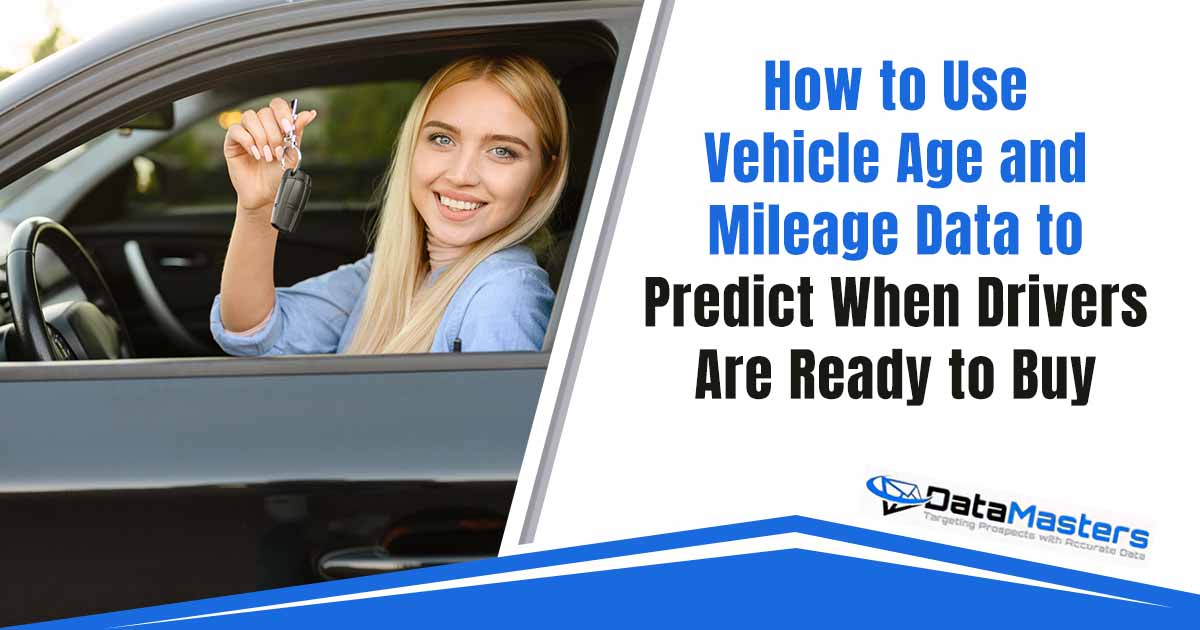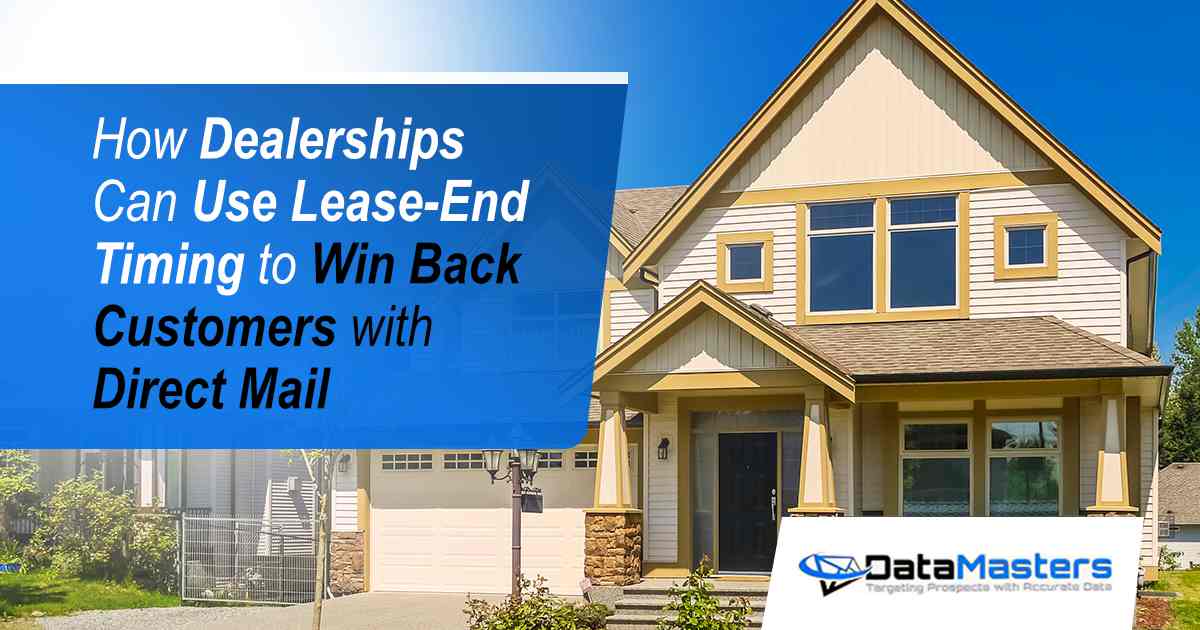Auto dealers, warranty providers, and vehicle upgrade services often face one challenge: reaching customers at the right time. Using auto database mailing lists filtered by vehicle age and mileage allows businesses to target drivers when they’re most likely to consider a new car, extended warranty, or repair service. These data points serve as reliable predictors of buyer readiness, especially for consumers with aging or high-mileage vehicles. With the right segmentation, marketers can time offers to match the natural lifecycle of a vehicle, before it becomes a financial burden to the owner.
Why Auto Database Mailing Lists Are Key to Smarter Marketing
An auto database mailing list is a curated collection of consumer records that includes vehicle-specific details such as make, model, year, and mileage. These lists provide powerful filtering capabilities that enable businesses to reach the most relevant audience. Instead of mass marketing to a broad set of drivers, companies can use segmentation to target those who are statistically more likely to act.
For example, a warranty provider can filter records for vehicles between five and seven years old and with over 75,000 miles. This audience is more likely to need coverage as their original warranties expire. Similarly, dealerships can time trade-in promotions to align with lease expirations or when older vehicles reach high-maintenance phases.
Segmentation enhances campaign performance by reducing wasted impressions, improving engagement rates, and increasing ROI. Auto database mailing lists are especially effective for:
- Dealerships targeting trade-in and upgrade opportunities
- Extended warranty companies seeking to pre-qualify high-risk owners
- Vehicle service providers aiming to reach drivers before breakdowns occur
When used strategically, these mailing lists enable marketers to transition from generic outreach to targeted, data-driven campaigns based on actual vehicle usage and lifecycle patterns.
The Power of Filtering by Vehicle Age
Understanding Vehicle Lifecycles
Vehicle age is a critical indicator in predicting when a driver may be ready to make a purchasing decision. Most new car leases range between 24 and 36 months. When those lease terms approach expiration, many drivers begin to explore trade-in options or new lease agreements. Similarly, vehicles between five and ten years old that are owned often begin to experience increased maintenance issues, leading many owners to consider replacing their vehicles rather than continuing to invest in repairs.
By filtering auto database mailing lists by vehicle year, businesses can identify segments of the population who are approaching the natural end of their vehicle’s lifecycle. For example:
- 3-year-old vehicles may indicate lease maturity
- 5–7-year-old vehicles often signal out-of-warranty status
- 10+ year-old vehicles suggest a high likelihood of replacement consideration
Segmenting by vehicle age allows marketers to anticipate consumer needs and engage with them before they actively start shopping, giving businesses a first-mover advantage.
Why Older Vehicles Signal Buying Intent
As a vehicle ages, the cost and frequency of maintenance typically rise. Drivers with older vehicles often face the decision of whether to invest in repairs or upgrade to a newer, more reliable model. This behavior presents a window of opportunity for marketers to position relevant offers.
When marketing to this segment through auto database mailing lists, businesses can:
- Promote trade-in bonuses to encourage early upgrade decisions
- Offer extended warranty coverage for vehicles nearing the end of their original protection
- Highlight fuel savings or safety upgrades available in newer models
By targeting drivers of older cars, companies can align their messaging with real-world pain points—such as rising repair bills or reduced reliability—making campaigns more timely and persuasive.
Using Mileage to Identify At-Risk Vehicle Owners
What Mileage Says About a Vehicle’s Condition
Mileage is one of the most reliable indicators of a vehicle’s overall wear and tear. While age reflects the passage of time, mileage reveals how much the car has actually been used. This distinction is crucial for marketers utilizing auto-database mailing lists to identify potential buyers or service customers.
Certain mileage milestones are strongly correlated with mechanical issues, increased maintenance costs, and decreased resale value:
- 60,000 miles – Start of major scheduled maintenance intervals
- 100,000 miles – Increased risk of system failures and high-cost repairs
- 150,000+ miles – Often triggers discussions of replacement
By filtering records for vehicles approaching or surpassing these thresholds, marketers can prioritize outreach to drivers most likely to need support, upgrades, or warranty coverage. These are high-intent segments that often respond well to relevant, data-driven offers.
How to Predict Upgrade Behavior with High Mileage
Drivers who own vehicles with over 100,000 miles are statistically more likely to consider replacing them in the next 6 to 12 months. This makes them ideal targets for campaigns promoting trade-ins, financing options, or maintenance plans. However, timing is key.
With access to auto database mailing lists segmented by mileage, marketers can:
- Launch upgrade offers just before major service intervals
- Highlight the cost savings of replacing vs. repairing
- Emphasize improved fuel economy and safety features in newer vehicles
Targeting by mileage helps businesses avoid marketing to customers too early in the vehicle ownership cycle and instead focus on those already evaluating their next move. This strategy enhances engagement, reduces churn, and generates more qualified leads for the sales funnel.
Combining Age and Mileage for Maximum Impact
Filtering by vehicle age or mileage alone provides useful insights, but combining both delivers significantly stronger results. When businesses use auto database mailing lists that segment by both metrics, they gain a clearer picture of the vehicle’s lifecycle stage and the driver’s likely needs.
For example, a seven-year-old vehicle with over 90,000 miles is far more likely to require major repairs, warranty coverage, or replacement than a similarly aged vehicle with only 45,000 miles. This dual filtering approach allows marketers to:
- Identify high-risk vehicles with aging components and high usage
- Tailor messaging to emphasize urgency (e.g., “before your next costly repair”)
- Optimize timing for extended warranty, service contract, or upgrade offers
Case Example: Targeting 7-Year-Old Vehicles with Over 90,000 Miles
Consider a dealership campaign targeting drivers whose vehicles are:
- Model Year: 7+ years old
- Mileage: 90,000+ miles
This segment is likely out of factory warranty, nearing critical maintenance intervals, and experiencing declining performance. Marketing efforts targeted at this group—such as trade-in incentives or pre-approved financing for newer models—are far more likely to be successful.
Using auto-database mailing lists filtered in this way allows marketers to reach these drivers before they take independent action. This proactive targeting drives higher response rates, lowers acquisition costs, and positions businesses as problem-solvers at just the right time.
Real-World Use Cases for Auto Database Mailing Lists
The value of filtered auto database mailing lists becomes even clearer when applied to real-world marketing efforts. By targeting specific vehicle segments based on age and mileage, businesses can engage the right customers with the right message at the right time. Below are three common use cases where this strategy delivers measurable results.
Dealerships: Perfect Timing for Trade-In Offers
Dealerships benefit significantly from targeting drivers whose vehicles are nearing the end of their lifecycle. By filtering auto mailing lists for vehicles over five years old or with more than 75,000 miles, sales teams can deliver timely trade-in offers that align with customer needs.
Key dealership strategies include:
- Promoting trade-in events to drivers with older or high-mileage vehicles
- Offering pre-qualification for financing or lease agreements
- Aligning campaigns with manufacturer incentives to boost urgency
By focusing outreach on owners ready for an upgrade, dealerships can increase showroom visits and reduce wasted marketing spend.
Extended Warranty Providers: Reaching Before the Breakdown
Warranty companies can use auto database mailing lists to identify when a vehicle is likely to lose its factory coverage or enter a high-risk phase for repairs. Timing is crucial—once a major repair occurs, the value of a warranty diminishes in the consumer’s eyes.
Strategies for warranty providers:
- Target drivers of vehicles between 60,000 and 100,000 miles
- Emphasize coverage before unexpected breakdowns
- Personalize offers based on vehicle type and age
Reaching out before mechanical issues begin helps establish trust and increases the likelihood of conversion.
Vehicle Upgrade Services: Spotting the Sweet Spot
Companies offering upgrade options—such as vehicle subscription services, lease buyouts, or financing alternatives—can identify the “sweet spot” in vehicle ownership by using combined filters.
Targeting vehicles:
- 6 to 8 years old
- 85,000 to 120,000 miles
This segment includes owners likely weighing the cost of repairs against the value of upgrading. With the right messaging, these campaigns can convert drivers before they begin actively shopping elsewhere.
Best Practices for Segmenting Auto Mailing Lists
To maximize the effectiveness of your campaigns, it’s essential to apply best practices when segmenting auto database mailing lists. Clean, relevant data ensures your message reaches the right audience with minimal waste and higher return on investment.
Cleaning and Updating Vehicle Records
Accurate data is the foundation of any successful direct mail campaign. Before launching, marketers should validate that vehicle records are up to date. This includes:
- Verifying current vehicle ownership and registration
- Removing records of sold or scrapped vehicles
- Confirming odometer estimates based on usage patterns
Working with a reputable data provider ensures that the auto database reflects actual vehicle conditions, making your segmentation strategy far more precise.
Geo-Targeting to Align with Local Market Demand
Combining age and mileage filters with geographic data enables marketers to target campaigns to high-conversion regions. For example, targeting older vehicles in areas with limited public transit may yield stronger results than urban centers with less reliance on personal vehicles.
Use geographic filters to:
- Prioritize ZIP codes with strong historical response rates
- Match offers with regional dealership inventory or warranty availability
- Reduce costs by eliminating low-potential territories
Smart geo-targeting enhances the cost-effectiveness of auto database mailing lists, enabling businesses to focus their efforts where they matter most.
Metrics That Matter: Measuring Campaign Success
Once a campaign using auto database mailing lists is launched, it’s critical to track performance and optimize future efforts based on the results. Success metrics should align with campaign goals—whether it’s lead generation, appointment setting, or conversions.
Key performance indicators (KPIs) include:
- Open and response rates – Evaluate how well the message resonates with the target segment
- Conversion rate – Measure how many recipients took the desired action (e.g., trade-in, service inquiry, warranty purchase)
- Cost per acquisition (CPA) – Assess how efficiently the campaign is driving results
- Return on investment (ROI) – Quantify the campaign’s profitability
Segment-level analysis can reveal which vehicle age and mileage ranges perform best. For example, vehicles between 6 and 8 years old with 90,000–110,000 miles may consistently generate higher conversion rates than other groups. This insight allows marketers to refine targeting for future campaigns and scale what works.
By continuously monitoring and refining based on data, businesses can unlock the full value of auto database mailing lists and build high-performing, repeatable campaigns.
📣 Ready to Reach Drivers Before Their Car Becomes a Problem?
Utilize auto database mailing lists from DataMasters to segment your audience by vehicle age, mileage, and location. Identify drivers at key decision points—before they search for alternatives—and deliver offers that match their needs. Contact DataMasters today at (469) 549-1800 to start building smarter, more timely campaigns that convert.




